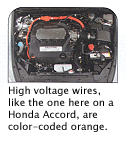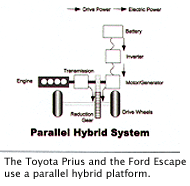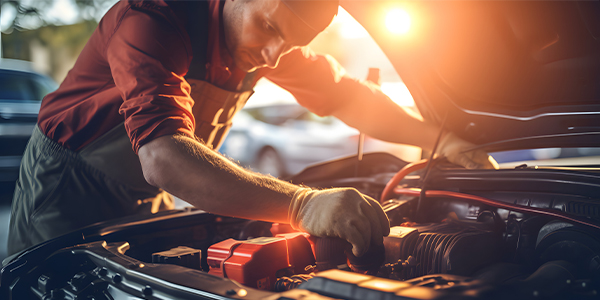Edward Sunkin has been the editor of Underhood Service since April of 1999. He has been a member of the Babcox family of automotive aftermarket publications beginning in December 1994, when he joined the jobber/parts specialist magazine Counterman as an associate editor. Edward also spent three years as managing editor Engine Builder, learning about the engine and small parts rebuilding and remanufacturing industry.
Besides Underhood Service, Edward also serves as the editor of Tomorrow’s Technician, an automotive-related trade magazine delivered to more than 50,000 students enrolled in NATEF-affiliated schools.
Anyone who has a vehicle is well aware of the record-breaking rise in fuel costs this year. And if you’ve been keeping up with the news, you’re probably reading about how car buyers are finding hybrid vehicles an attractive way to reduce their travel and commuting costs. Even Congress has helped make hybrids more appealing by including new hybrid vehicle purchase tax credits in its recently approved energy bill.
But with any type of change comes a lot of misinformation, and the same can be said with hybrid vehicles.
The good news for your shop is that more hybrid vehicles equates to an increase in service opportunities. But is your shop and are your technicians ready to service hybrid vehicles? If not, you should learn how you can meet the challenges of servicing hybrids and how this growing car market can create additional business opportunities for you. Remember, not every independent shop is ready to service hybrids, and the trip to the dealership for regular maintenance at times could be an inconvenience for the vehicle owner. If the hundreds of thousands of hybrid vehicles projected to reach the roads in the next couple of years becomes a reality, independent technicians will be called upon to help meet the hybrid service demands. Some estimate that by 2011, 20% of the vehicles on the road will be hybrids.
For the most part, servicing hybrid vehicles is like any other vehicle that needs regularly scheduled maintenance – there’s oil to change; coolant to flush; transmission fluid to replace; air, oil and cabin filters to change. However, there are new precautions to follow that technicians must learn before servicing these vehicles. For example, a tech must remove the key from the hybrid’s ignition, since the engine may start up automatically if the vehicle is in "ready mode" and it wants to charge up its high-voltage battery.
Shunning Service?
A lot of "mysteries" and "myths" about hybrids have circled around the service repair industry since the first hybrids debuted in this country in 2000. According to Bob Rodriguez, technical specialist for the National Institute for Automotive Service Excellence (ASE), there is no reason for skilled automotive technicians to fear hybrid electric vehicles (HEV). That said, anyone going beyond "routine" vehicle maintenance on hybrids should get authorized training.
"We’ll see many more gasoline (and diesel) electric hybrids pretty soon, all leading the way to the hydrogen fuel cell vehicle (FCV), which is itself another form of hybrid," says Rodriguez. "So why not get started now?"
In December 2004, Underhood Service sampled some of our readers to see if their shops had yet serviced a hybrid vehicle. Nearly 14% of those shops responded, "Yes," while 82% responded "No." Interestingly, 4% responded "Not Sure."
Shops also were asked "What preparations have you made for servicing hybrid vehicles in your shop?" About 25% responded that they have acquired service information on hybrids, 3% said one or more of their techs received training specifically for servicing hybrids, and 4% said they had acquired tools specific to hybrids.
For next year’s "Underhood Service Repair Market Profile" (October 2006 issue) we will again survey shops to determine if independent shops have improved in the call to service hybrid vehicles.
Hybrids Explained
As vehicle manufacturers look for ways to improve fuel economy and designate their vehicle as a "hybrid" the concept has become a bit confusing. In simple terms, any vehicle that combines two or more sources of power is considered a hybrid. The most common hybrids use a combination of a rechargeable battery and a gasoline engine, (though diesel engines are being considered to replace gasoline engines in some designs).
 According to Rodriguez, these vehicles can be partially or totally propelled using electric drive motor(s) – either induction (IM) or permanent magnet (PM) type, operating off of high-voltage, 3-phase alternating current. A power inverter changes the battery pack’s high voltage DC into 3-phase AC for the drive motor(s), and the motor controller supplies the motor varying amounts of AC and voltage (in both directions) to determine vehicle speed and direction as requested by the motorist. Much like a torque converter slips to add torque when vehicle load increases, the electric motor uses "slip angle" to multiply torque. The drive/gear reduction unit is coupled to the motor shaft and reduces high RPM to useable axle RPM.
According to Rodriguez, these vehicles can be partially or totally propelled using electric drive motor(s) – either induction (IM) or permanent magnet (PM) type, operating off of high-voltage, 3-phase alternating current. A power inverter changes the battery pack’s high voltage DC into 3-phase AC for the drive motor(s), and the motor controller supplies the motor varying amounts of AC and voltage (in both directions) to determine vehicle speed and direction as requested by the motorist. Much like a torque converter slips to add torque when vehicle load increases, the electric motor uses "slip angle" to multiply torque. The drive/gear reduction unit is coupled to the motor shaft and reduces high RPM to useable axle RPM.
In most HEVs, small, low-voltage Nickel-Metal Hydride battery "modules" are wired in series to produce the battery pack’s high DC output voltage. NiMH battery temperatures are controlled, as are other power electronics devices. A DC/DC converter supplies 12 volts for conventional automotive devices.
According to the hybrid information website www.hybridcars.com, there are two styles of hybrids – full and mild.
 A Full Hybrid describes a vehicle that can move forward at low speeds without consuming any gasoline or diesel. Here, the hybrid vehicle can be driven by just the electric motor or the engine independently or together. The Toyota Prius and the Ford Escape are considered full hybrids. (Full hybrids are also called parallel hybrids since the engine and the electric motor are hooked up in parallel to the same transmission.)
A Full Hybrid describes a vehicle that can move forward at low speeds without consuming any gasoline or diesel. Here, the hybrid vehicle can be driven by just the electric motor or the engine independently or together. The Toyota Prius and the Ford Escape are considered full hybrids. (Full hybrids are also called parallel hybrids since the engine and the electric motor are hooked up in parallel to the same transmission.)
Mild Hybrid vehicles move from a standstill only if the internal combustion engine is engaged, and use the electric motor primarily to assist the gas engine when extra power is needed. So the electric motor is never the sole source of driving power. The hybrids from Honda and the GM trucks use the mild hybrid system.
However, both full and mild hybrids require use of the gas engine when reaching speeds of about 20-25 mph and above.
Of course, it doesn’t end there. Mild hybrid systems can be broken down into subcategories:
A Stop/Start hybrid system, like the ones used on GM trucks, shuts the engine off when it would otherwise idle and restarts it instantly on demand (taking off).
An Integrated Starter Alternator with Damping (ISAD) hybrid system allows the electric motors to help move the vehicle in addition to providing stop/start capability.
An Integrated Motor Assist (IMA) hybrid system, which is similar to the ISAD, but has a larger electric motor and more electricity can be used to help move the vehicle.
Safety Issues
As with any new technology, there’s a lot of mystique about hybrid vehicle safety. According to Rodriguez, the high voltage battery packs, 3-phase AC, converters, inverters, controllers, etc., all present new challenges and concerns for today’s technicians. (To address consistency among various models, automakers have color-coded the wiring of high-voltage systems on HEVs orange.)
However, Rodriguez said there’s no need for alarmist reactions, and the fact is, with redundant safety systems and well-protected high-voltage components and wiring, hybrids have an excellent safety record.
Rodriguez said the best way to prevent high voltage/ current from flowing in a hybrid electric vehicle is to simply turn off the key, disconnect the negative 12 VDC battery cable, or turn off safety switches. (See "Vehicle High Voltage Switch Locations.)
Rodriguez said black (inflatable) lineman’s gloves rated for 1,000 volts should be worn whenever servicing the high voltage system to avoid shock or electrocution. And, because the chemicals associated with NiMH batteries are caustic and will react with certain metals or liquids, safety goggles, rubber aprons, and other gear is required when working with or around such batteries.
Training Availability
As these vehicles become more popular with American drivers, classes are popping up all over the country to teach independent car mechanics about hybrids. Some industry experts estimate that there are more than 200,000 hybrid vehicles on the roads today. Though most training is available from the hybrid manufacturers, you may find helpful safety training by calling your local the fire department, or by attending various automotive association conferences mentioned below.
Hybrid manufacturers have made it a point to educate local emergency response teams on the safety issues regarding their vehicles. Often, local fire departments will hold classes with other emergency and rescue personnel to go over various hybrid vehicle safety issues. Contact your local fire department to see if it will be holding a hybrid emergency response class, or if emergency personnel would come to your shop and provide valuable safety, towing and hybrid electrical high-voltage instruction to your technicians.
Automotive Service Association’s (ASA) Congress of Automotive Repair and Service (CARS) Tech Seminar: "Advancing Down the Hybrid Highway," 8:15-11:30 a.m., Friday, Nov. 4 at The Mirage in Las Vegas.
Craig Van Batenburg, AAM, sponsored by the Automotive Career Development Center, will lead an advanced session for those who have studied or worked on hybrid vehicles. It will highlight Ford, Honda, GM, Toyota and Lexus specific information to include battery and high voltage concerns, interpreting hybrid scan tool data, techniques to determine if the engine or hybrid drive is causing the driveability concern, common problems and more.
For registration details, forms and other conference information, visit www.asashop.org.
Automotive Training Managers Council (ATMC) Fall Conference, Monday, Oct. 3 at the Sheraton Music City Hotel, Nashville, TN. "Medium-Duty Hybrids and Fleet Training Challenges," 9:15-10 a.m. presented by David Simmons, FedEx.
"Ford Hybrid Escape, 1-Year Later: Field Service Issues and Training Effectiveness," 10:15-11:15 a.m. presented by Jim Groat, Ford Motor Company.
For registration details, forms and other conference information, visit www.atmc.org.

 According to Rodriguez, these vehicles can be partially or totally propelled using electric drive motor(s) – either induction (IM) or permanent magnet (PM) type, operating off of high-voltage, 3-phase alternating current. A power inverter changes the battery pack’s high voltage DC into 3-phase AC for the drive motor(s), and the motor controller supplies the motor varying amounts of AC and voltage (in both directions) to determine vehicle speed and direction as requested by the motorist. Much like a torque converter slips to add torque when vehicle load increases, the electric motor uses "slip angle" to multiply torque. The drive/gear reduction unit is coupled to the motor shaft and reduces high RPM to useable axle RPM.
According to Rodriguez, these vehicles can be partially or totally propelled using electric drive motor(s) – either induction (IM) or permanent magnet (PM) type, operating off of high-voltage, 3-phase alternating current. A power inverter changes the battery pack’s high voltage DC into 3-phase AC for the drive motor(s), and the motor controller supplies the motor varying amounts of AC and voltage (in both directions) to determine vehicle speed and direction as requested by the motorist. Much like a torque converter slips to add torque when vehicle load increases, the electric motor uses "slip angle" to multiply torque. The drive/gear reduction unit is coupled to the motor shaft and reduces high RPM to useable axle RPM.  A Full Hybrid describes a vehicle that can move forward at low speeds without consuming any gasoline or diesel. Here, the hybrid vehicle can be driven by just the electric motor or the engine independently or together. The Toyota Prius and the Ford Escape are considered full hybrids. (Full hybrids are also called parallel hybrids since the engine and the electric motor are hooked up in parallel to the same transmission.)
A Full Hybrid describes a vehicle that can move forward at low speeds without consuming any gasoline or diesel. Here, the hybrid vehicle can be driven by just the electric motor or the engine independently or together. The Toyota Prius and the Ford Escape are considered full hybrids. (Full hybrids are also called parallel hybrids since the engine and the electric motor are hooked up in parallel to the same transmission.) 






